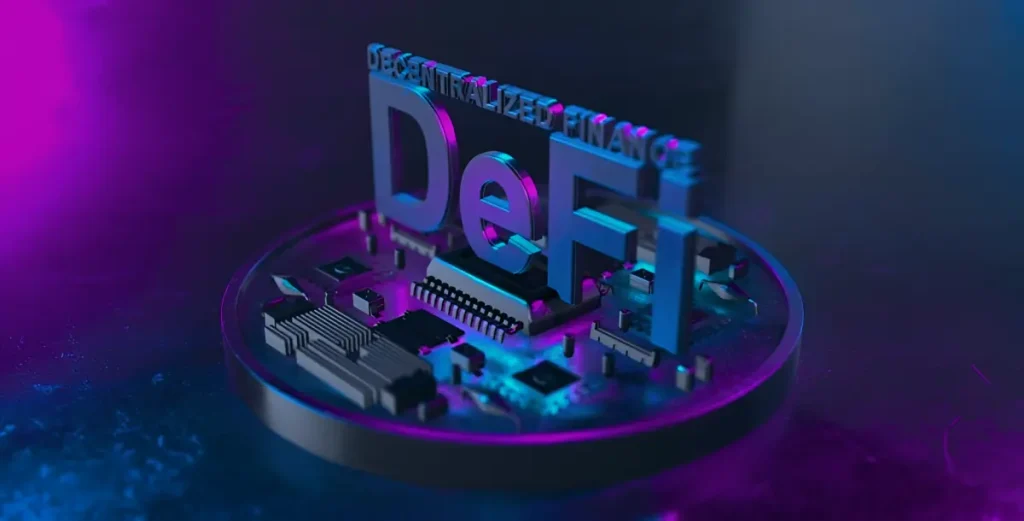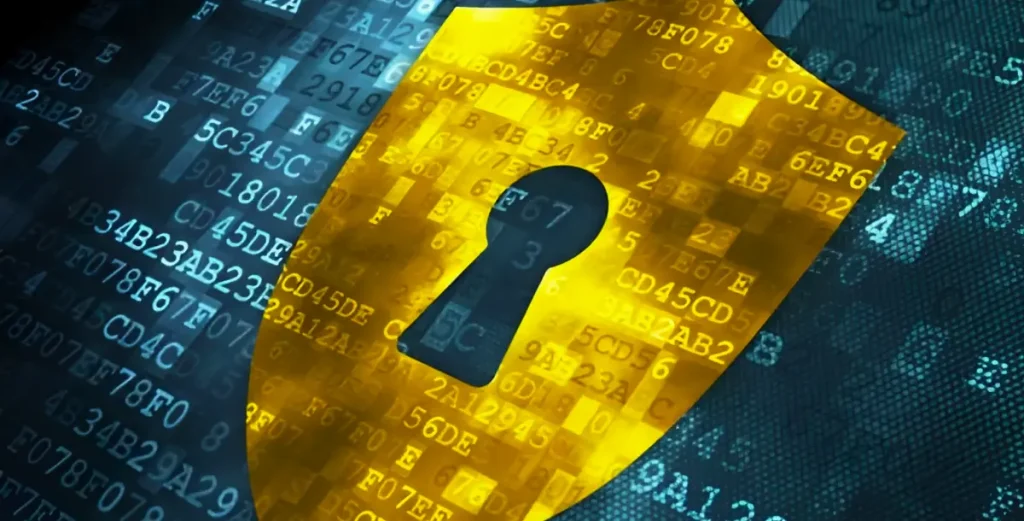Decentralized Finance (DeFi), powered by blockchain and smart contracts, is redefining financial services by eliminating the need for banks, governments, or other traditional intermediaries, significantly reducing settlement times and operational costs. This streamlined approach makes financial transactions more efficient and transparent—key benefits for businesses seeking an edge source.
For business leaders, DeFi presents opportunities to access liquidity, optimize treasury operations, and develop innovative financial products. This guide will outline what matters most for decision-makers: how DeFi works, strategic use cases, potential risks, and safe integration into business practices.
DeFi Definition Explained in Simple Terms
At its core, DeFi is like online banking, but without the bank. Traditional finance relies on institutions like banks, credit unions, and insurance companies to facilitate transactions, store money, and provide loans. These institutions act as trusted intermediaries—they hold your money and make decisions about who gets loans and at what rates.
Decentralized finance flips this model entirely. Instead of relying on institutions, DeFi uses blockchain networks (primarily Ethereum) and smart contracts to automate financial services. Think of smart contracts as computer programs that automatically execute agreements when certain conditions are met—no human intervention required.
Here’s how the two systems compare:
Traditional Finance:
- Centralized control by banks and institutions
- Limited operating hours (9-5, weekdays only)
- Geographic restrictions and KYC requirements
- Higher fees due to multiple intermediaries
- Slower settlement times
Decentralized Finance:
- No central authority or intermediary
- Available 24/7 globally
- Open to anyone with internet access
- Lower fees through automation
- Near-instant settlement
The technology powering DeFi crypto includes blockchain networks, smart contracts, and decentralized applications (dApps). These work together to create a financial ecosystem that operates transparently and automatically.
How DeFi Works: The Technology Behind It
Understanding how DeFi works requires grasping two key concepts: smart contracts and blockchain networks.
Smart Contracts: The Engine of DeFi
Smart contracts are self-executing contracts with the terms of agreement directly written into code. When you use a DeFi app for lending, for example, a smart contract automatically handles everything—from verifying collateral to calculating interest rates to processing payments. No loan officer, no paperwork, no waiting for approval.
Here’s a simple example: You want to lend your cryptocurrency and earn interest. In traditional finance, you’d deposit money with a bank that pays you a small percentage while lending your money at higher rates. In DeFi, you deposit your crypto into a lending protocol’s smart contract. The contract automatically matches you with borrowers and distributes interest payments based on supply and demand.
DeFi Apps and Protocols
DeFi apps are user interfaces that interact with underlying smart contracts. These applications handle everything from basic token swaps to complex financial instruments. Popular categories include:
- Lending and Borrowing: Platforms like Aave and Compound let you earn interest on deposits or borrow against collateral
- Decentralized Exchanges (DEXs): Uniswap and SushiSwap enable peer-to-peer trading without intermediaries
- Yield Farming: Protocols offer rewards for providing liquidity to various pools
- Synthetic Assets: Platforms create tokenized versions of real-world assets
The Role of Decentralized Finance Companies
While DeFi aims to eliminate intermediaries, decentralized finance companies still play crucial roles in building and maintaining these platforms. These organizations develop the smart contracts, create user interfaces, and often provide governance for protocol upgrades. However, unlike traditional financial institutions, they don’t control user funds or make unilateral decisions about protocol operations.
Real-World Examples of DeFi in Action
To understand decentralized finance (DeFi) in practical terms, let’s examine how people use these protocols today:
Lending and Borrowing Without Banks
Maria, a freelancer from Brazil, needs a $5,000 loan but doesn’t meet her local bank’s requirements. Using a DeFi lending protocol, she deposits $7,500 worth of Ethereum as collateral and borrows stablecoins instantly. The entire process takes minutes, requires no credit check, and operates automatically through smart contracts.
Earning Yield on Savings
Traditional savings accounts offer interest rates around 0.1-0.5% annually. DeFi protocols often provide significantly higher yields. Users can deposit stablecoins (cryptocurrencies pegged to the dollar) into lending pools and earn anywhere from 3-15% annually, depending on market conditions.
Trading Around the Clock
Unlike stock markets that close on weekends and holidays, decentralized exchanges operate continuously. Traders can swap cryptocurrencies, provide liquidity to earn fees, or access complex financial instruments like options and futures—all without creating accounts or providing personal information.
Creating Synthetic Assets
Some DeFi protocols allow users to create synthetic versions of real-world assets like stocks, commodities, or currencies. This gives global access to traditional markets without the barriers of geographic restrictions or account minimums.
The user experience typically involves connecting a digital wallet to a DeFi app, which then interacts with the underlying smart contracts. While this process has become more user-friendly, it still requires some technical knowledge and understanding of the risks involved.
Why People Are Turning to DeFi
The growth of DeFi isn’t just about technology—it addresses real problems that millions face with traditional financial systems.
Financial Accessibility
Approximately 1.7 billion adults worldwide lack access to basic financial services. DeFi requires only an internet connection and a smartphone, making financial services available to anyone regardless of location, credit history, or identity documentation.
Transparency and Trust
Every DeFi transaction occurs on public blockchains, creating unprecedented transparency. Users can verify exactly how protocols work, track all transactions, and audit the code themselves. This transparency builds trust without requiring faith in institutions.
Higher Yield Potential
DeFi protocols often offer better returns than traditional financial products. By eliminating intermediaries and overhead costs, more value flows directly to users. However, these higher returns come with increased risks that users must understand.
Global Access and Speed
DeFi operates 24/7 across borders without requiring permission from any authority. This global accessibility is particularly valuable for people in countries with unstable currencies or restrictive banking systems.
Innovation and Composability
DeFi protocols can integrate with each other like building blocks, creating new financial products that would be impossible in traditional systems. This “money legos” concept enables rapid innovation and customized financial solutions.
Some DeFi Facts You Should Know About
While DeFi offers exciting opportunities, it’s crucial to understand the significant risks involved.
Smart Contract Vulnerabilities
Smart contracts are code, and code can have bugs. Hackers have exploited vulnerabilities to steal millions of dollars from DeFi protocols. Even audited contracts can contain unknown flaws, and users bear the risk of total loss.
Regulatory Uncertainty
Governments worldwide are still developing regulations for DeFi. Future regulations could restrict access to protocols, affect token values, or create compliance burdens that change how DeFi operates.
Market Volatility and Liquidation Risk
Cryptocurrency prices are highly volatile. If you use crypto as collateral for loans, sudden price drops can trigger automatic liquidation, resulting in significant losses. This risk is particularly acute in leveraged positions.
User Experience and Technical Complexity
DeFi still requires technical knowledge that many users lack. Mistakes in wallet addresses, gas fee miscalculations, or protocol interactions can result in permanent fund loss. The complexity barrier remains high for mainstream adoption.
Liquidity and Counterparty Risks
Some DeFi protocols depend on sufficient liquidity to function properly. During market stress, liquidity can disappear rapidly, making it difficult to exit positions. Additionally, some protocols have centralized elements that create counterparty risks.
Is DeFi safe to use? The honest answer is that it depends on your risk tolerance and technical expertise. What is the biggest problem in DeFi? Currently, it’s the combination of technical complexity and the irreversible nature of blockchain transactions, which means user errors often result in permanent losses.
Real-World DeFi Applications for Individuals and Businesses
DeFi offers practical tools that extend beyond individual investing, providing strategic advantages for businesses as well. Instead of viewing it solely as an investment vehicle, consider its function as an alternative financial infrastructure. Here are a few established, real-world examples of how both consumers and businesses are using DeFi protocols.
NOTE: This information is for educational purposes only and should not be considered financial or investment advice.
Use Case 1: Earning Yield on Stablecoins
- For Individuals: Many people use DeFi to earn a return on their stablecoins (digital assets pegged to a currency like the US dollar). By lending stablecoins on established platforms, users can earn variable interest rates that are often higher than those offered by traditional savings accounts. This allows them to generate passive income on their holdings with less volatility than other cryptocurrencies.
- For Businesses: This same mechanism serves as a powerful treasury management tool. A company holding a significant cash position can convert a portion to stablecoins and lend them in DeFi protocols. This can generate a higher yield than a standard corporate savings account, helping to protect cash reserves against inflation and putting idle capital to work.
Use Case 2: Staking on Layer-2 Networks
- For Individuals: Staking involves locking up cryptocurrency to help secure a network, and in return, participants earn rewards. On Layer-2 (L2) networks, staking is often more accessible due to lower transaction fees. Individuals can participate in securing these networks and earn staking rewards, contributing to the ecosystem’s health while growing their assets.
- For Businesses: For companies building on or interacting with blockchain networks, staking offers a dual benefit. It provides a way to earn a return on corporate crypto holdings and can also grant governance rights within the protocol. This allows a business to have a say in the future development of the technology it relies on, aligning its financial interests with its strategic technological choices.
Use Case 3: Accessing Decentralized Exchanges (DEXs)
- For Individuals: Decentralized exchanges allow users to trade digital assets directly from their own wallets without needing a central intermediary. This provides access to a wide range of tokens, often before they are listed on major centralized exchanges. Users can swap assets 24/7 while maintaining full custody of their funds.
- For Businesses: A business may need to exchange one type of digital asset for another to pay vendors, manage multi-currency payroll, or rebalance its digital asset portfolio. DEXs provide an efficient and automated way to perform these swaps with transparent, on-chain settlement. This reduces reliance on a single exchange and can lower counterparty risk.
The Future of DeFi and What Comes Next
The DeFi ecosystem continues evolving rapidly, with several trends shaping its future.
Layer-2 Solutions and Scalability
High gas fees on Ethereum have driven development of layer-2 solutions that offer faster, cheaper transactions while maintaining security. Solutions like Polygon, Arbitrum, and Optimism are making DeFi more accessible to smaller investors.
Institutional Adoption
Traditional financial institutions are beginning to explore DeFi technologies. Some are building their own blockchain solutions, while others are integrating DeFi protocols into existing services. This institutional interest could drive mainstream adoption but might also introduce regulatory oversight.
Cross-Chain Interoperability
Future DeFi development focuses on connecting different blockchain networks, allowing assets and data to flow seamlessly across ecosystems. This interoperability could unlock new possibilities and reduce reliance on any single blockchain.
Improved User Experience
Decentralized finance companies are working to simplify user interfaces and reduce technical barriers, with aggregation layers emerging as a key solution. These platforms bundle multiple DeFi protocols into a single, streamlined interface. By doing so, aggregation layers automatically find the best rates for trades or loans across various sources, simplifying transaction processes and abstracting away the underlying complexity. Future developments will likely focus on even better wallet integration and error prevention, making the DeFi ecosystem more accessible to a broader audience.
Regulatory Clarity
As governments develop clearer regulatory frameworks, DeFi may become more stable and predictable. However, regulation could also limit certain activities or require protocol modifications to ensure compliance.
Is DeFi the Right Choice for You?
DeFi represents a paradigm shift in finance, offering unprecedented access, transparency, and innovation. The potential benefits are significant: higher yields, global access, and financial services without gatekeepers.
However, these benefits come with substantial risks. Smart contract vulnerabilities, regulatory uncertainty, and technical complexity create challenges that traditional finance doesn’t face. The irreversible nature of blockchain transactions means mistakes can be costly.
DeFi is most suitable for organizations that:
- Have a strong understanding of blockchain technology and its risks
- Can afford to manage potential losses
- Are experienced with cryptocurrency and decentralized systems
- Value the principles of decentralization and self-sovereignty in their financial strategies
For companies new to DeFi, partnering with an established technology provider can help you navigate the ecosystem safely and effectively.




